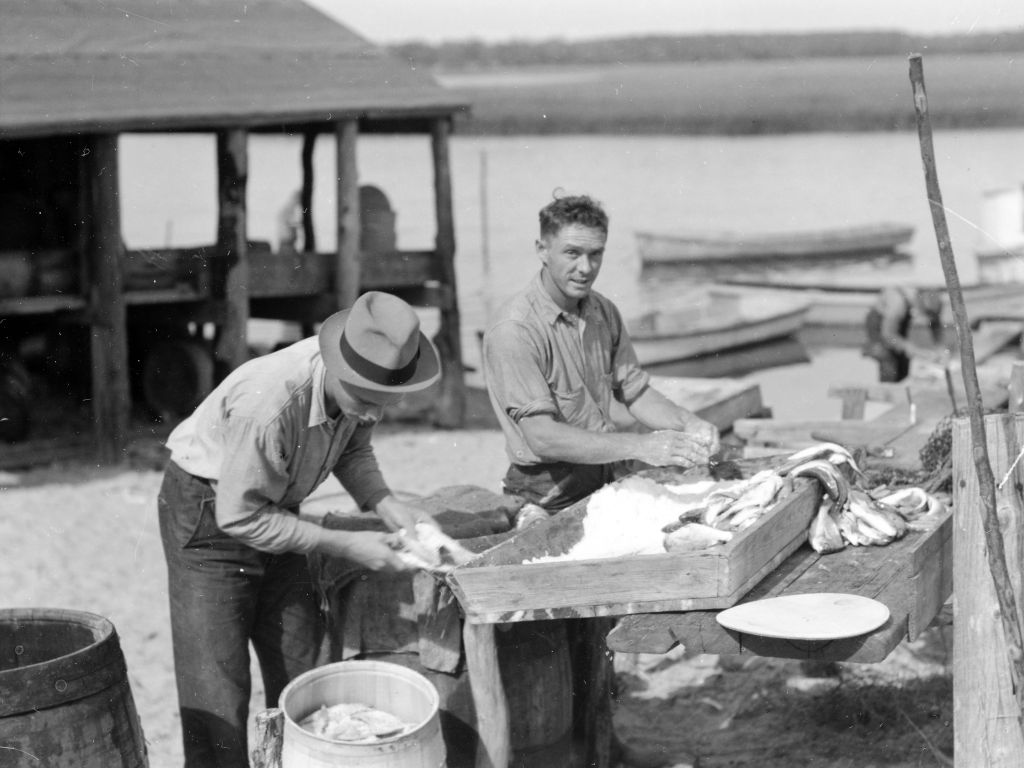
Swansboro Area Mullet Fisheries
Swansboro Area Mullet Fisheries
by Frank Tursi
The mighty red drum is the official state fish. Powerful bluefin tunas off the Outer Banks inspire TV dramas. Majestic marlins spawn fishing competitions that can make contestants rich. Popular saltwater fish, like flounder, speckled trout and king mackerel, support the state’s multi-billion-dollar fishing industries.
But the lowly mullet is North Carolina’s first fish.
Striped mullets, more commonly called “jumping mullets” for their aerial, acrobatic displays, are one of the great schooling fishes of the Atlantic. The babies, the ubiquitous “finger mullets,” crowd our sounds and coastal rivers and creeks in untold numbers throughout the spring and summer. Come fall, those that have grown to adults gather in huge schools for their annual southern migration.
Where great masses of fish go, masses of men with nets naturally follow.
Highly prized for their flesh and roe, striped mullet fueled the first commercial fishery along the state’s coast. It boomed to prominence after the Civil War and continues more than a century later, though now much-diminished. By the 1870s, more mullets were caught in North Carolina than in any other state. Thirty or more ships carried the fish from Beaufort and Morehead City to far-off northern cities where they fed poor immigrants flooding into the country. The old N.C. Railroad to Morehead hauled away so many mullets that for generations locals called it the Old Mullet Road. Barrels of salted mullets became as common in country stores across Eastern North Carolina as jars of pickled eggs.
Most of the men who caught those fish were part-time fishermen. They made their livings as farmers and merchants and tradesmen of one kind or another. Some were mere schoolboys. But they all gathered on the coast in late summer with their skiffs and cotton nets to reap the annual bonanza. Some lived for weeks at a time in makeshift, temporary fishing camps that were scattered along the beaches and sounds from Hatteras Inlet to the S.C. line.
“Mullet fishing was a really important part of life along a big stretch of the coast from the 18th century to the 1950s,” explained David S. Cecelski, a historian who has written extensively about the N.C. coast. “From Hatteras to the other side of Wilmington, every bit of the beach would have been carved out by mullet camps.”
Cecelski, who splits his time between Durham and his native Carteret County, will tell the story of one of those camps on Monday, Feb. 19, at a program sponsored by the Swansboro Historical Association. His talk, which will feature 1938 photos of a camp on Brown’s Island in Onslow County, will begin at 6 p.m. in the auditorium of One Harbor Church at 502 S. Church Street.
Leaping All Over the World
If you’ve spent any time on the water, you’ve seen them. Biologists speculate why mullets jump. Some think they’re trying to escape predators; others suspect that the fish leap out of the water to breath in needed oxygen. Here’s an alternate, though less scientific, suggestion: They jump for the pure joy of it.
Whatever the reason, striped mullets (Mugil cephalus) do their jumping all over the world. They are found in coastal waters from Nova Scotia to Central America, from southern California to Chile, from the Bay of Biscay in France to South Africa. You’ll see them jumping in the Mediterranean and the Black seas, in the Arabian Sea, in the Bay of Bengal and in the Philippine and Coral seas.
Here, in North Carolina, the mullets congregate in large schools in our inshore waters. In late summer and fall, they begin to move offshore to spawn.
Austin Guthrie knew to watch the weather for the first signs of a “mullet blow.” “Nature would tell you when the mullet would begin to move,” remembers Guthrie, 87, who as a teenager fished with a mullet crew, led by his father, from old Cedar Point Beach on Bogue Sound. “When the wind would blow strong from the southwest for three or more days in the fall, we knew it would shift to the north and then the mullet would begin to move.”
Men, perched atop wooden towers built at strategic places along the shoreline, would be looking for them. Those assigned the task had an “eye for mullet.” They scanned the water for the telltale signs of schools just below the surface – large areas of ripples, dark spots that moved against the tide and current, silver bodies that leaped into the air. When they spied a school within reach of shore, the lookouts hollered to the fishermen below, waving a branch of wax myrtle or yaupon.
The crews of 12 to 30 men would then spring to life, launching their small, wooden pilot skiffs to splay out the shallow-water nets used to corral the approaching fish and haul them to the beach.
The Sound of Distant Thunder
One fisherman remembered how large the schools of fish could get and how they inspired awe and, it seems, a bit of irritation. “During the fall they move in such immense schools that the noise of their splashing resembles distant thunder and to persons living near the bay this noise kept up day and night becomes very annoying,” the fisherman told R. Edward Earll in the 1880s.
Earll was a young biologist for the U.S Fish Commission. He was helping G. Brown Goode of the Smithsonian Institution compile the first comprehensive study of the U.S. fishing industry. For his research, Earll visited mullet camps throughout the Southeast. He lingered on Core and Bogue banks in Carteret County, which at the time was the center of mullet fishing in North Carolina.
It was a wild, exotic world of sand dunes, thick stands of live oak forests and vast expanses of salt marshes and deserted beaches. Groupings of odd, thatched houses with round walls and conical roofs, which Cecelski speculates traced their architectural roots to Africa, dotted the shoreline of the islands. They were built by the men who had come for generations, from farms and shops from as far away as New Bern and Edenton.
“People would come down to the shore every year and join the same gang every year,” Cecelski explained. “It was a social thing. All these guys – and it was almost exclusively guys – would head off and live out there on their own for two or three months.”
In his report on mullet in “The Fishery and Fishing Industries of the United States, Vol. 1” that Goode published in 1887, Earll describes methods, customs and a language that had developed over many decades and would remain in place for a century longer. The men, for instance, would begin gathering at the camps around the first of August and would remain until mid-November. They fished in crews led by a captain, who usually owned the boats and nets. They each got “shares” in the catch depending on their labors, talents or the equipment they brought with them. The captain got multiple shares, of course. As did the lookout and man who owned the land where the camp was built. Everyone got at least one share, including those who delivered firewood and freshwater each day. Each share, in Earll’s day, was worth the fetching price of a 100-pound barrel of salted mullet.
The fish were salted at the camps, Earll reported, and packed in those barrels, which were sent by boat to buyers in Beaufort and Morehead City.
Guthrie’s father, Elbert, used the same financial arrangement, or “lay,” with his crews when he fished for mullet 80 years later. Elbert Guthrie had been evicted in 1941 from the family homestead in Bogue in Carteret County when the government bought land for a training field for pilots. He moved a few miles away to Cedar Point, settling along Bogue Sound at the end of what is now Bell Street. There, he had a public popular swimming beach with a hot dog stand and a picnic shelter and such. Business sort of died when the bridge to Emerald Isle was completed in 1972, opening the ocean beaches.
Elbert closed the swimming beach each fall because that was mullet time.
Austin Guthrie was rowing one of the boats that day in 1952 or ’53 – he can’t remember which year exactly – when his daddy’s crew caught 57,000 pounds of mullets, which Guthrie says is the biggest single haul of mullets ever caught in Bogue Sound. His rowing duties earned him an extra half share along with his full share. It amounted to about $300. “That was real good money back then,” he says. “We could make money, even for the few cents a pound daddy sold the fish. There were that many mullet.”
Waving the White Flag
The late Tucker Littleton, a Swansboro historian, describes numerous mullet fishing crews operating in the Swansboro area around the turn of the 20th century. Relying on the memories of family members, Littleton, in a 1980 newspaper article, lists more than 20 mullet crews working in such places as Dudley’s Island at Bogue Inlet, at the mouths of Queens and Fosters creeks, at Brown’s Inlet in Onslow County and in Goose Bay and Sander’s Island in Carteret.
Many of the men in these crews arrived at the fishing grounds in the morning and returned home that night. One such crew in Cedar Point, fishing at the mouth of the White Oak River, near the eastern end of the current causeway, would hoist a white flag up a tall pole when the mullets were plentiful, Littleton writes. Many of the crew members came from Swansboro, rowing each morning across the river to fish. The flag, which could be seen in town, let their wives back home know that the fishing was good. Littleton reports that the crew once raised the flag on 27 consecutive days.
The custom was followed for many years, Littleton explains, but had to be stopped after some of the fishermen complained that their wives broke out the Sears and Roebuck catalog when seeing the flag, and their shares were spent before they rowed back home that evening.
Photographer Charles Farrell visited the mullet camp on Brown’s Island in 1938 and left behind a valuable photographic record that’s now preserved by the state’s Division of Archives and History. The owner of the first photo shop in Greensboro, Farrell had for years crisscrossed the coast and had developed an affinity for the rough-hewn life of fishermen. “He had a talent for capturing their common, everyday lives,” Cecelski says.
Two fishing families, the Lawrences and the Gillikins, from far-off Otway along Wards Creek in Down East Carteret County had started the camp on Brown’s Island. Year after year, the men from these families would make the two-day sail to Brown’s each August to fish for mullet. They would return home before Thanksgiving.
Bedford Lawrence, 70 when Farrell visited, was the head of one the clans. He had been coming to Brown’s since the 1880s. He poses for Farrell in a faded denim jacket and a hat he had waterproofed with linseed oil. The wry smile hints of the fiddle player that Lawrence was back home at the North River Primitive Baptist Church.
Leonard Gillikin, the boss of the fishing crew, gives it his Hollywood best for the camera, tilting his felt fedora at a rakish angle and holding his pipe ramrod straight in his mouth. He’s descended from the legendary Decatur Gillikin, a Paul-Bunyan-like character who could row farther and faster than anyone. Not to go too far off track, but’s here’s a story relayed by an attendant at the Minnesott Beach Ferry who hailed from Down East. It was likely once told in fish houses from Cedar Island to Straits: Decatur was also an expert wrestler who challenged anyone to a match. A Yankee showed up one day to wrestle but Decatur wasn’t home. The Yankee said he’d wait and asked Decatur’s daughter if he could have a drink of water. It being a hot day and all. She directed him to the water barrel out back. The Yankee found the big, wooden barrel but no ladle. He returned to the house. Decatur’s daughter followed him back to the barrel. “I thought you’d do like everyone around here does,” she said, lifting the barrel and taking a drink. The Yankee left and was never seen again.
Life at a Mullet Camp
To get us back on track, Farrell’s photos provide a glimpse into the everyday lives of these mullet fishermen. He shot them sleeping on their dried seaweed mattresses, a bible by their side. He shot them cooking meals. And, no, they didn’t eat a lot of mullet, Cecelski explains. It was too valuable. They ate spot, because there was no market for that fish. He shot their pigs rooting around the fish-cleaning tables. No, they didn’t eat them either, Cecelski reports, because the bacon tasted too much like fish. He shot them salting fish and nailing the carcasses and the salted roe sacks, which look like bunches of bananas, on the walls of cabins to dry.
The big roe mullet could fetch several dollars, instead of the usual few cents a pound. Salted and dried, the roe sacks would last almost forever. “I used to wrap one up in paper and take it to school,” Austin Guthrie remembers. “I’d take it out of my pocket every once in awhile and take a bite like a snack.”
“In the old days, you would see salt fish drying constantly,” Cecelski says. “You would have seen them drying on porches. People would hang them from clothes line. It was something everyone did.
Once ice becomes more affordable and there are more ice houses, then it all changed. Everything then goes to the fresh market. Salt only made sense when ice wasn’t available.”
Like salted mullet, it’s all mostly gone now, existing only in the fading memories of old men and in a handful of black-and-white photos. A crew fishes for mullets each year from the beach at Salter Path on Bogue Banks, and occasional crews haul boats and nets along the beaches on Core Banks. Even the mullets themselves have taken a turn. Commercial catches have dropped steadily over the last few years, and the state now considers the health of the species to be of a “concern.”
David Guthrie, Austin’s younger brother, will always have his pictures and the stories that go with them. “They were good times,” he says, holding a picture of his father seated in the lookout tower. “Everyone would come down to the beach when we were hauling the nets and the fishing was good. Word would get around and people would come and look. The beach would be full of people. Fishing for mullet and spot and even scallops when the weather got real cold was all part of life here.”
 Previous Post
Previous Post Next Post
Next Post